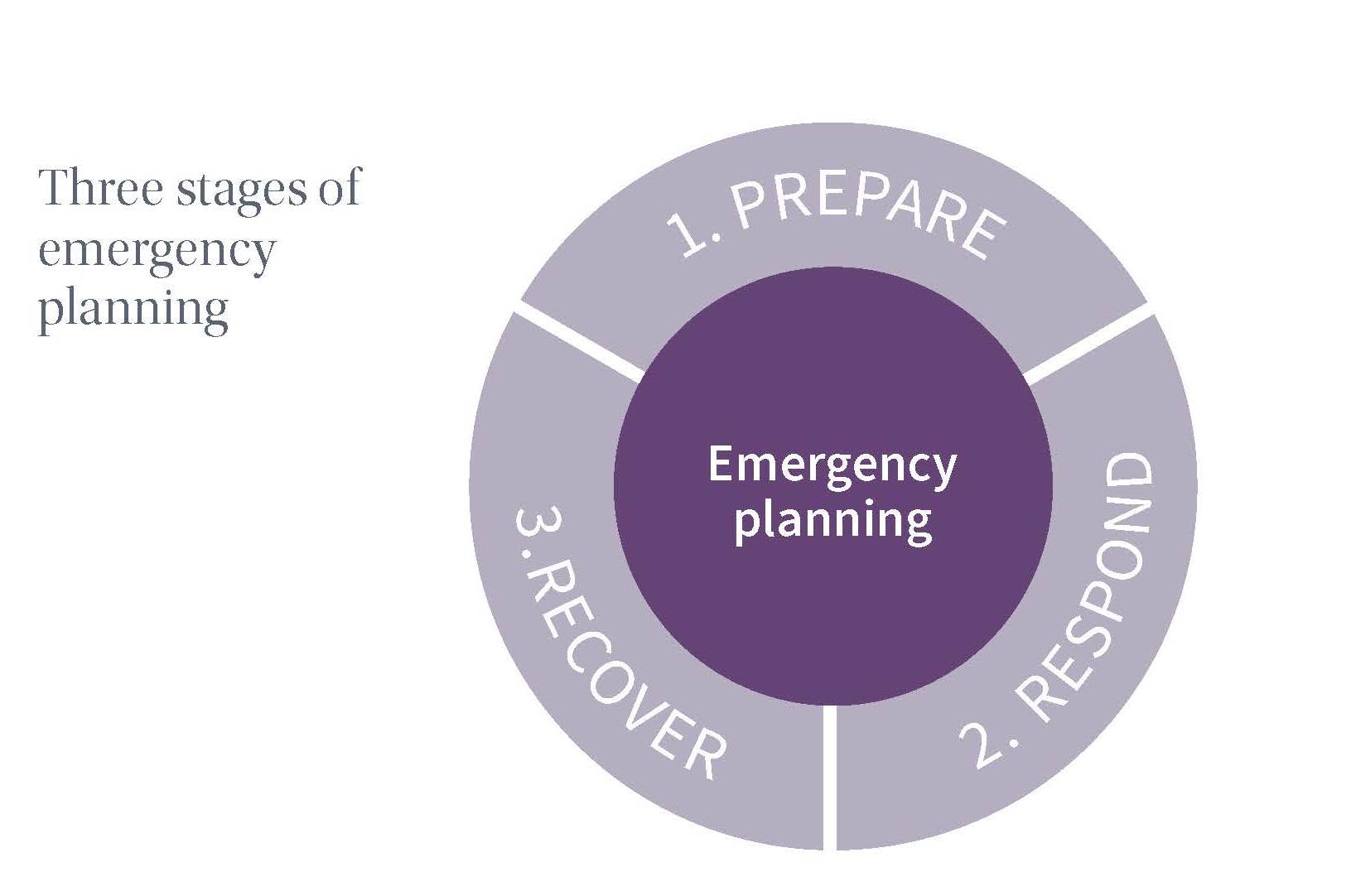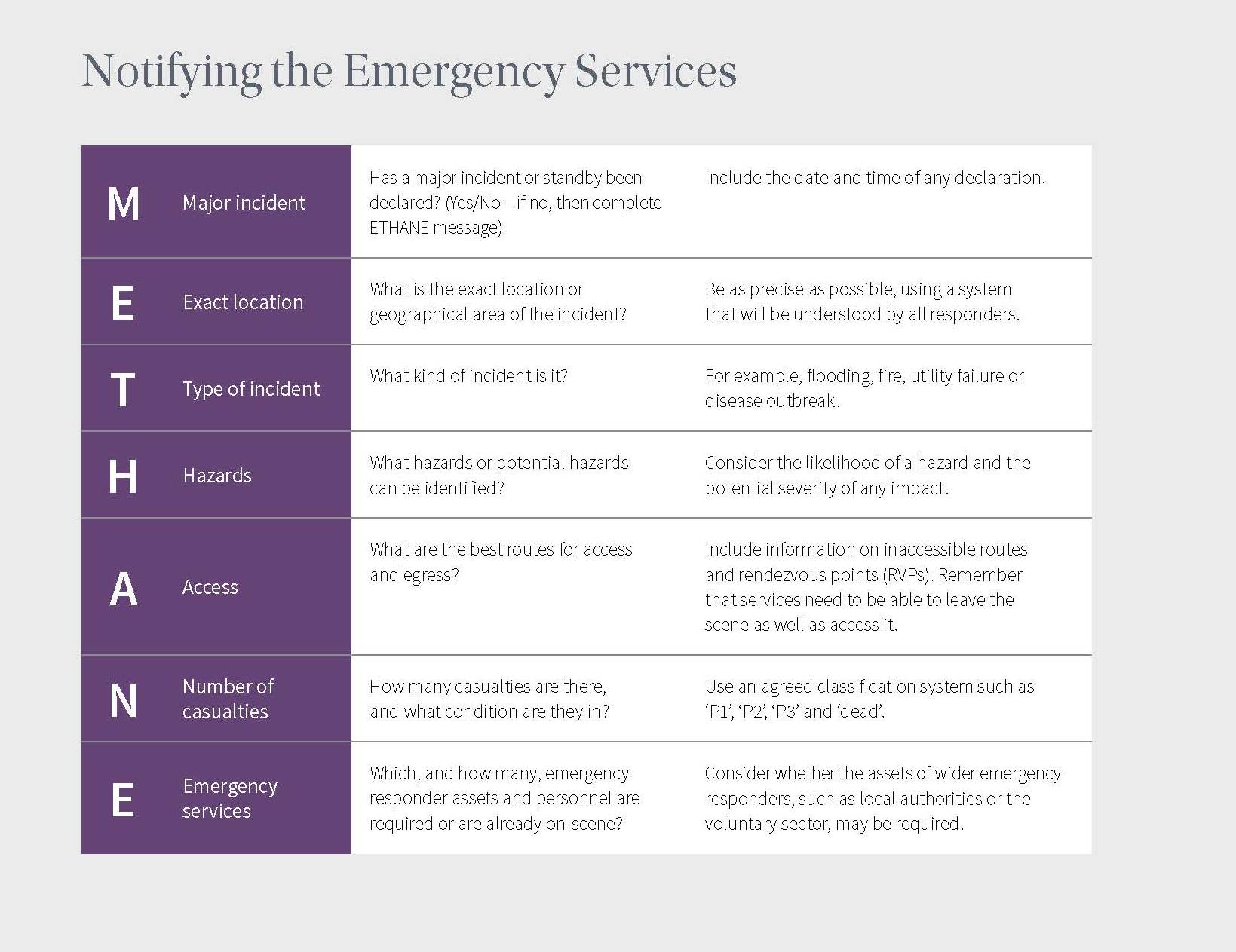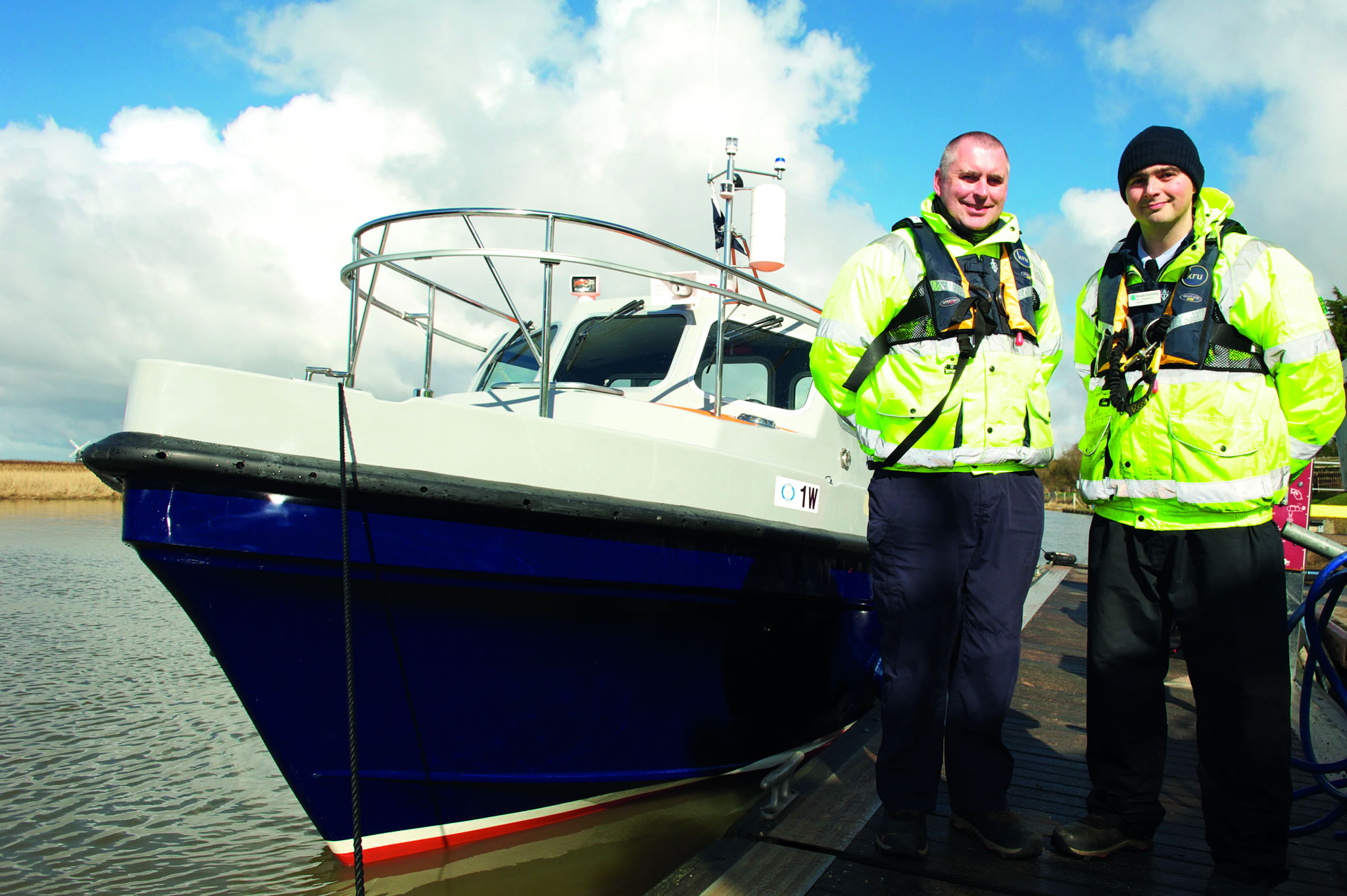How do we decide whether there is an emergency? What triggers an emergency plan? How do we deal with situations so that an emergency is prevented through contingency planning?
This section provides a framework for emergency planning and additional advice on how to deal with terrorist threats and manage safety at events.

How do we decide whether there is an emergency? What triggers an emergency plan? How do we deal with situations so that an emergency is prevented through contingency planning?
This section provides a framework for emergency planning and additional advice on how to deal with terrorist threats and manage safety at events.

An emergency is a sudden, urgent, usually unexpected occurrence requiring immediate action.
WHAT IS EMERGENCY PLANNING?
Emergency planning is the process of assessing risks and finding ways to mitigate them or reduce their impact by putting in place an emergency plan. The plan should include measures to handle sudden or unexpected situations and clearly show what needs to be done; how, when and by whom.
If your safety plan is in place and being followed, the potential for emergency situations will be reduced. However, even with good planning and sound management, emergencies will still occur. Sometimes it will be a result of events outside your control or caused by the actions of visitors. On occasions an emergency may be due to the failure of your own systems. Therefore you must ensure that emergency procedures are in place, practised and understood.
In Great Britain and Ireland, we have become accustomed to such good public emergency services that we may fail to plan or train adequately for emergencies. It is only when a situation arises that our lack of planning and preparation is exposed. Effective emergency procedures will enable your staff and volunteers to ensure the prompt involvement of the emergency services if required. They will also help you to manage the situation until the emergency services arrive, and will make their intervention more effective. Staff trained to follow a good emergency plan should be able to judge what actions to safely take in order to:
- help sustain life and prevent further injury
- contain any hazardous situations
- prevent access by staff, volunteers and the public to hazardous areas or situations
- evacuate the site• prevent or minimise damage to property
- prevent or minimise damage to the environment.
Emergency planning involves three key steps that should form part of a process of continual reflection and review.
Prepare
Think things through. What are the possible hazards? What types of disaster can you imagine? Have you done everything you can to prevent an incident? Are you fully prepared if one does occur? Thorough preparation will include information gathering, risk assessment and mitigation planning.
Respond
Your plan should include general guidance on how to react to an emergency, together with specific steps to be taken to respond to each type of emergency or hazard that you identified during the preparation stage.
Recover
Recovery involves determining the consequences of an event and putting in place any actions necessary to return to business as usual. Have a process to review what happened, share information and agree future control measures
[block_anchor] => emergency-planning [block_format] => section_heading [block_introduction_title] => [block_custom_subnav] => [block_section_heading] => Emergency planning [product] => [product_text] => ) [2] => stdClass Object ( [block_count] => 2 [layout] => text_block [slug] => block-59ac4e75 [title] => [source] => page [visibility] => 0 [background_colour] => bg-transparent [block_width] => indent [width] => stdClass Object ( [container_class1] => mb-4 [container_class2] => container [container_class3] => bg-transparent py-4 ) [class] => fcb-text_block [content] =>
The first phase of preparation is to gather as much information as possible about your organisation’s operations. Consider how different operations interact and assess where the vulnerabilities lie.
Carry out risk assessments based on this analysis to understand the potential impacts of events. Involve all the staff necessary to ensure that every important aspect is covered.
Each site will have a unique combination of risks. However, there are some foreseeable emergencies that are generic. You should consider:
- serious accidents or illness to staff, volunteers or visitors
- incidents that could lead to serious injury including, for example, people trapped underground, cut off by rising tide, in difficulty climbing
- effects of severe weather conditions like snowdris, flooding, landslips, falling trees
- fire involving buildings
- forest, heath or moorland fire (including fire on adjoining land)
- serious pollution
- chemical contamination
- unexploded ordnance
- terrorist activity such as a vehicle used as a weapon, bomb threats and weapons-attack
- serious criminal activity particularly where its effects impact on infrastructure or operations
- missing person.
WRITING AN EMERGENCY RESPONSE PLAN
Once risk assessments are complete, you should develop an Emergency Response Plan. This will normally be written down, clearly setting out the limits of actions to be taken by employees and volunteers during an emergency.
In its simplest form, an emergency plan is a collection of key contacts, instructions and guidance needed in an emergency. Anyone using the plan is likely to be in a challenging and stressful situation. Key information must be easily accessible at the front of the plan.
It should follow a logical order; for example evacuation procedures followed by a contact list and then a site plan marking utility shut-off points and hazards to the emergency services. Include written procedures to deal with foreseeable emergencies. The document must be workable and comprehensive, yet made as simple as possible and easy to read.
Consider involving the emergency services in preparing the plan. This is particularly important if the site has highvisitor numbers, is very complex or has unusual hazards.
Check what information the emergency services need. Do they prefer maps, postcodes or grid references?
Make sure all staff and volunteers likely to be involved in dealing with an emergency are aware of the response plan. Provide them with training, if necessary.
Where appropriate, explain emergency procedures to visiting groups.
Prepare prompt sheets listing important information to be passed to the emergency services and keep them at suitable positions. This should follow the METHANE system shown below.
[block_anchor] => prepare [block_format] => section_heading [block_introduction_title] => [block_custom_subnav] => [block_section_heading] => 1. Prepare [product] => [product_text] => ) [3] => stdClass Object ( [block_count] => 3 [layout] => text_block [slug] => block-b1321bdf [title] => [source] => page [visibility] => 0 [background_colour] => bg-transparent [block_width] => indent [width] => stdClass Object ( [container_class1] => mb-4 [container_class2] => container [container_class3] => bg-transparent py-4 ) [class] => fcb-text_block [content] =>THE FIFTEEN MINUTE PLAN
Despite thorough planning being in place, events can be unpredictable or their progression uncertain. On these occasions, there is even greater need for rational thought, decisive action and clear direction.
The immediate need is to identify the nature of the incident and assess its scale.
The first fifteen minutes are often critical. The person in charge, whether first responder or nominated senior manager, must bring some degree of control to the situation and set in train actions to:
- maximise safety and minimise danger
- mitigate escalation (stop it spreading or getting worse)
- communicate direction to others
- secure support and assistance.
This may involve notifying the emergency services. In order to assist their understanding of what has happened, they may seek information using a standard template applicable across all of their roles. This is referred to in the mnemonic METHANE.

TRAINING AND TESTING
Test your response plan. Regular training exercises ensure that people using the plan are familiar with it and it is kept up to date. Training under simulated conditions provides the most realistic feedback as to the strengths and weaknesses of your emergency procedures. Desk exercises can test how well the plan supports decision-making for different scenarios. Consider inviting the emergency services to participate in training exercises.
Review the effectiveness of your response to a practice or real emergency, learn any lessons and revise your procedures, if necessary. Review the procedures regularly
[block_anchor] => respond [block_format] => section_heading [block_introduction_title] => [block_custom_subnav] => [block_section_heading] => 2. Respond [product] => [product_text] => ) [4] => stdClass Object ( [block_count] => 4 [layout] => text_block [slug] => block-badd77b0 [title] => [source] => page [visibility] => 0 [background_colour] => bg-transparent [block_width] => indent [width] => stdClass Object ( [container_class1] => mb-4 [container_class2] => container [container_class3] => bg-transparent py-4 ) [class] => fcb-text_block [content] =>
IMMEDIATE ACTIONS
If possible, leave the scene as it is until investigators have seen it. If you have to make changes, keep a record of the circumstances and take photographs beforehand. Consider whether you have a legal requirement to report a fatality, injury or dangerous occurrence to your enforcing authority. (This is covered in more detail in Chapter 6.)
Your own organisation should have established procedures for internal reporting and dealing with insurance claims.
Check the safety of any structures, fences, bridges and the like that may have been damaged in the emergency. You may need to involve specialists such as building surveyors or tree surgeons.
WHEN BACK TO NORMAL…
Lessons can be learnt from any emergency situation. Prepare a report containing details of the emergency and the actions taken to deal with it, as soon after the incident as practicable. Any failings in the emergency procedures should be identified and changes made. Share your findings with others who might benefit.
[block_anchor] => recover [block_format] => section_heading [block_introduction_title] => [block_custom_subnav] => [block_section_heading] => 3. Recover [product] => [product_text] => ) [5] => stdClass Object ( [block_count] => 5 [layout] => resources_block [slug] => block-ebd8160c [title] => Useful Information [source] => page [visibility] => 0 [background_colour] => bg-transparent [block_width] => container [width] => stdClass Object ( [container_class1] => container mb-4 [container_class2] => bg-transparent py-4 [container_class3] => ) [class] => fcb-resources_block [resources] => Array ( [0] => Array ( [resource_type] => link [resource_link] => Array ( [title] => Health and Safety Executive Guide to emergency planning: [url] => http://www.hse.gov.uk/toolbox/managing/emergency.htm [target] => _blank ) [resource_file] => ) [1] => Array ( [resource_type] => link [resource_link] => Array ( [title] => Government guidance that promotes a more collective approach to emergency planning involving cooperation between individuals, businesses and the wider community: [url] => https://www.gov.uk/government/publications/preparing-for-emergencies/preparing-for-emergencies [target] => _blank ) [resource_file] => ) [2] => Array ( [resource_type] => link [resource_link] => Array ( [title] => Government guidance on planning for a major incident or disaster, building resilience and recovery: [url] => https://www.gov.uk/government/publications/business-continuity-planning [target] => _blank ) [resource_file] => ) [3] => Array ( [resource_type] => link [resource_link] => Array ( [title] => Historic England advice to on how to plan for emergencies in buildings: [url] => https://historicengland.org.uk/advice/technical-advice/emergency-and-fire/emergency-planning-advice/ [target] => _blank ) [resource_file] => ) [4] => Array ( [resource_type] => link [resource_link] => Array ( [title] => The Emergency Planning College provides training courses and consultancy services: [url] => https://www.epcresilience.com/ [target] => _blank ) [resource_file] => ) [5] => Array ( [resource_type] => link [resource_link] => Array ( [title] => Scottish Government's guidance document for wildfire incidents: [url] => https://www.gov.scot/publications/fire-rescue-service-wildfire-operational-guidance/pages/1/ [target] => _blank ) [resource_file] => ) [6] => Array ( [resource_type] => link [resource_link] => Array ( [title] => what3words location system provides a free app that provides a simple way to advise responders of your location: [url] => https://what3words.com/about-us/ [target] => _blank ) [resource_file] => ) ) [block_anchor] => ) [6] => stdClass Object ( [block_count] => 6 [layout] => text_block [slug] => block-0de4fc06 [title] => [source] => page [visibility] => 0 [background_colour] => bg-transparent [block_width] => indent [width] => stdClass Object ( [container_class1] => mb-4 [container_class2] => container [container_class3] => bg-transparent py-4 ) [class] => fcb-text_block [content] =>For several years the threat of terrorism in the UK has been rated by the Security Service as either substantial or severe, becoming critical on two occasions. This means that the risk of attack is likely, highly likely, or highly likely in the near future. The threat level in Ireland is also subject to constant review.
Terrorist tactics continually change, so it is not easy to predict potential targets or methodologies. However, enough is known to help us plan to avoid and deter the most likely events, minimising the impact as far as possible.
The first step is to understand the attack methodologies and assess the likelihood of your property being attacked. Terrorists are more likely to target iconic venues or events, large crowds and VIPs. So, if you have a number of sites, give priority to those at greatest risk.
The overwhelming purpose of your counter terrorism policy is to protect your staff, visitors, and property from harm by using proportionate measures in response to threats as they evolve.
There may be sites where physical security measures such as hostile vehicle mitigation are required. However, the emphasis for most sites will be on awareness training for staff, good planning and putting response procedures in place.
Being able to spot hostile reconnaissance and respond effectively might be the difference between being targeted or not; responding to an unfolding situation by acting quickly and in accordance with a few simple, pre-planned procedures could save lives.
[block_anchor] => counter-terrorism [block_format] => section_heading [block_introduction_title] => [block_custom_subnav] => [block_section_heading] => Counter terrorism [product] => [product_text] => ) [7] => stdClass Object ( [block_count] => 7 [layout] => text_block [slug] => block-1a9f101a [title] => [source] => page [visibility] => 0 [background_colour] => bg-light-grey [block_width] => full [width] => stdClass Object ( [container_class1] => container-fluid bg-light-grey p-4 mb-4 [container_class2] => container [container_class3] => ) [class] => fcb-text_block [content] =>USEFUL INFORMATION
NaCTSO is the central police unit that supports a network of about 190 counter terrorism security advisors (CTSAs) within police forces around the country. Their primary role is to provide help, advice and guidance on all aspects of counter terrorism protective security. Their website provides all the latest advice and resources, including Stay Safe video (Run, Hide, Tell), the ACT elearning module and Crowded Places guidance.
https://www.gov.uk/government/organisations/national-counter-terrorism-security-office
[block_anchor] => [block_format] => full_width [block_introduction_title] => [block_custom_subnav] => [block_section_heading] => Counter terrorism [product] => [product_text] => ) [8] => stdClass Object ( [block_count] => 8 [layout] => text_block [slug] => block-e8dd82e2 [title] => [source] => page [visibility] => 0 [background_colour] => bg-transparent [block_width] => indent [width] => stdClass Object ( [container_class1] => mb-4 [container_class2] => container [container_class3] => bg-transparent py-4 ) [class] => fcb-text_block [content] =>Advice from the National Counter Terrorism Security Office (NACTSO)


Become a member of the Visitor Safety Group
Why subscribe?
Become a member of the Visitor Safety Group
THE CONTENT ON THIS PAGE IS ONLY AVAILABLE TO VSG MEMBERS AND SUBSCRIBERS
CLICK HERE TO READ ABOUT MEMBERSHIP BENEFITS AND HOW TO BECOME A MEMBER
- Expert advice and support from a friendly and welcoming network
- Unlimited access to full guidance on all safety topics
- Free PDFs of all our publications
- Free attendance at workshops and webinars
ALTERNATIVELY, YOU CAN SUBSCRIBE FOR 24 HOUR ACCESS TO MEMBER-ONLY CONTENT
- Access to full guidance on all safety topics
- Access to resources from past webinars and workshops
- Free PDFs of VSG Industry Updates
Already a member? Log in